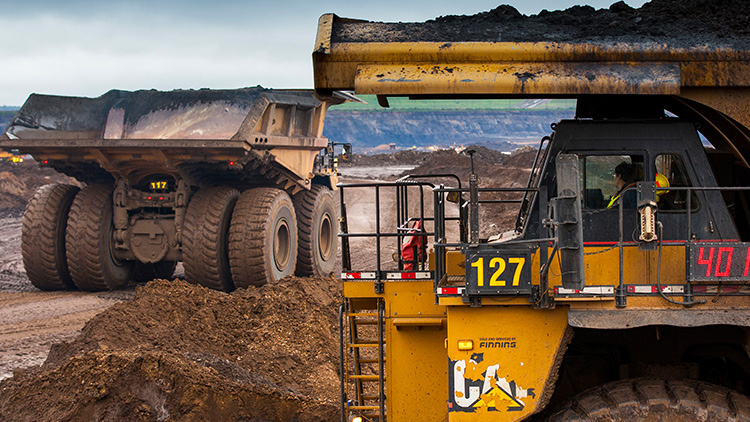Oil sands
Canada’s oil sands in Alberta and Saskatchewan are among the largest oil reserves in the world.

A heavy hauler driver safely navigates around the Shell Albian Sands’ Athabasca Oil and Sands Project, Canada.
Oil sands are a mixture of sand, water, clay and heavy oil called bitumen. In 2016, Shell was the operator and majority shareholder of the Athabasca Oil Sands Project (AOSP), a joint venture between Shell Canada (60%), Chevron Canada Limited (20%) and Marathon Oil Canada Corporation (20%). The AOSP consists of the Albian Mines (Muskeg River and Jackpine mines), the Scotford Upgrader, which processes bitumen into synthetic crude oil and Quest Carbon Capture and Storage.
Managing emissions
Crude oils produced from oil sands emit more greenhouse gas (GHG) emissions than the average crude oil used in the USA, according to data and analytics company IHS Markit. However, the GHG intensity of Shell’s oil sands operations has been on an improving trend due to performance enhancements and the launch of our Quest carbon capture and storage (CCS) project.
In 2016, its first full year of operation, Quest exceeded its annual target of capturing 1 million tonnes of CO2 and storing it safely underground.
Compared to 2015, we reduced our energy intensity by around 5% in 2016. A pilot programme at Shell Albian Sands has led to improvements in energy efficiency and emissions reduction by removing lower quality materials, such as clay, from the oil production process. This allows for lower temperatures to be used to release the oil from the ore, reducing energy consumption. As members of Canada’s Oil Sands Innovation Alliance we are exploring advanced energy-efficiency techniques with other oil sands producers.
We have also supported the Government of Alberta’s climate leadership plan, which includes a carbon pricing regime, a cap on oil sands emissions, and a reduction in methane emissions.
Water use and recycling
Oil sands mining operations use water to separate bitumen from the sand and generate steam for utilities. We explore ways to use less water. For example, we work to eliminate steam leaks and to reuse water and steam condensate from the production process. We manage our tailings and the storage systems, such as ponds, to increase the volume of water we recycle and capture and to prevent impacts to local watercourses and groundwater.
In 2016, these various approaches helped us increase water recycling in our mines by almost 8%. Our total fresh water intake for 2016 increased slightly. This was because we needed more water to dilute the higher calcium concentrations in our recycled water, the result of lower-than-average precipitation and snow melting in the region.
Tailings technology
The separation of bitumen from oil sands creates tailings - a mixture of water, sand, clay, residual hydrocarbons, trace heavy metals and other chemicals. These tailings are stored in ponds that allow the solids to settle so the water can be recycled.
The total area used for storing tailings at the Muskeg River and Jackpine mines was around 46 square kilometres at the end of 2016. This is in line with government-approved mine development plans as the tailings areas increase to support ongoing production and to help fill mined areas with solid tailings for future reclamation.
Shell supports the Alberta government Tailings Management Framework, which aims to minimise fluid fine tailings and accelerate the process of reclaiming the land. Over the past decade, we have invested around C$474 million to develop technologies that speed up the treatment process for fluid tailings. In 2016, we processed around 3.7 million cubic metres of fluid fine tailings at our Albian site.
Indigenous communities
Shell continues to work closely with indigenous communities in Canada to reduce the impact of oil sands development on traditional land use and culture, while bringing benefits to these communities.
The Canadian Council of Aboriginal Business has certified Shell for its work in aboriginal relations across four areas: employment, business development, community investment, and community engagement. The certification was decided by an independent jury made up of represenatatives from aboriginal businesses.
One example of our aboriginal engagement in 2016 involved the Fort McKay community advisory group. As part of this collaboration, elders joined us to plant trees at a Muskeg River Mine reclamation site.
Since 2005, Shell has spent nearly C$1.9 billion with local indigenous contracting companies.
Reclamation
Reclamation is an important part of the development of our oil sands mines. Before mining, the surface soils are removed and stockpiled for future reclamation. We reclaim the land by refilling the mined-out areas with tailings and restoring the contours of the disturbed land. We then replace surface soil and plant native vegetation on the sites.
By the end of 2016, Shell had permanently reclaimed a total of 221 hectares of land and planted almost 1 million trees and shrubs at the Albian mine sites.
Wildfire emergency response
In May 2016, a wildfire spread across around 590,000 hectares in northern Alberta, Canada, triggering a state of emergency and destroying portions of the Regional Municipality of Wood Buffalo, including parts of Fort McMurray near our oil sands operations.
We temporarily suspended the Shell Albian Sands mining operations to focus our resources on the safety of our people and the wider community. This included feeding and sheltering thousands of people and their pets at our Albian Village work camp, and the safe evacuation of 9,920 displaced employees, contractors and community members took place from Shell’s Albian Aerodrome. At about 80 kilometres north of the city, our mining site remained safe and secure from the wildfire. Shell emergency response teams in Fort McMurray provided support to local and provincial fire crews and Shell donated fuel to first responders in the region.
In March 2017, Shell agreed to sell to Canadian Resources Limited (Canadian Natural) its 60% interest in the AOSP, accounted for as a joint operation, its 100% interest in the Peace River Complex in-situ assets including Carmon Creek, and a number of undeveloped oil sands leases, all in Alberta, Canada. The consideration is approximately $8.5 billion, comprising $5.4 billion in cash and around 98 million Canadian Natural shares currently valued at $3.1 billion. The transaction is estimated to result in a post-tax impairment loss of $1.3 billion to $1.5 billion, subject to adjustments. In a related transaction, Shell and Canadian Natural have agreed to jointly (50:50) acquire Marathon Oil Canada Corporation (MOCC), which has a 20% interest in the AOSP, for $1.25 billion each. Following these transactions, Shell will continue as operator of the Scotford upgrader and the Quest CCS project. Subject to regulatory approvals, the transactions are expected to close in mid 2017. Subject to closing of these transactions and additional further conditions, Shell may swap its purchased interest in MOCC for a 20% interest in the Scotford Upgrader and Quest. If the swap were to occur, Shell would fully exit AOSP mining operations and have a 20% interest in the Scotford Upgrader and Quest.
